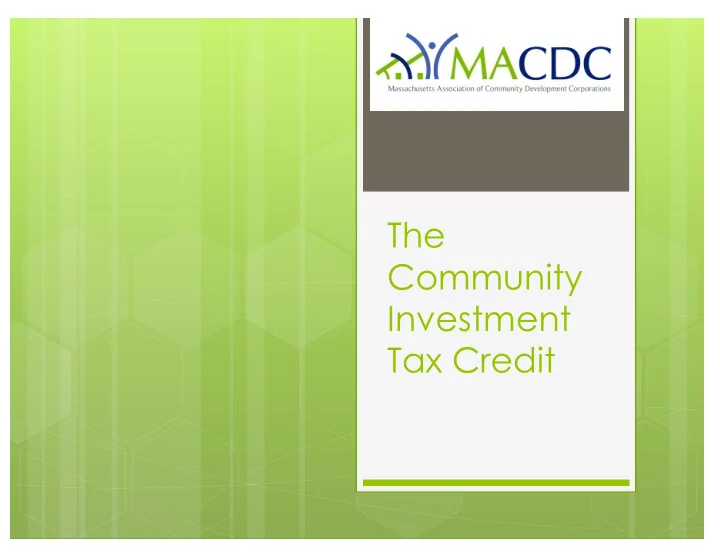

The Community Investment Tax Credit
CDC: Theory of Change with 2016 Member Data
From 2007 to 2016, MACDC Members have: � Invested $4.3 billion in the Mass economy � Supported 510,906 families � Built or preserved 14,058 homes � Created or preserved 37,316 jobs � Helped 18,092 small business owners and entrepreneurs We accomplish this work by engaging nearly 2,000 community leaders each year.
Goal of the Community Investment Tax Credit (CITC) “To enable local residents and stakeholders to work with and through community development corporations to partner with nonprofit, public and private entities to improve economic opportunities for low- and moderate-income households and other residents in urban, rural and suburban communities across the Commonwealth."
CITC: The Details � The CITC provides a 50% donation tax credit for qualified contributions to selected community development corporations. � $3 million in tax credits in 2014 � $6 million each year between 2015 and 2019. � CITC donations can support a broad array of community development efforts, as determined by the local community, including: Unrestricted operating support � Affordable Housing � Job Development � Business Development � Neighborhood Revitalization � Anything that is part of the CDC’s Community Investment Plan �
How are CDCs selected? � The Department of Housing and Community Development administers a competitive process for awarding CITC credits to CDCs. � Annual NOFA, with unused credits offered on rolling basis � CDCs can receive between $50,000 and $150,000 in credits � Allocations are based on quality of CDC’s community investment plan
Community Investment Plans Description of service area 1. Description of how residents shaped plan 2. Goals 3. Activities 4. Evaluation methods 5. Collaborators & partners 6. Integration of CDC plan with larger efforts in 7. the community Financing strategy 8. Prior track record 9.
Community Investment Plans � For some CDCs this has been standard practice; for others it is new and challenging � Pushes CDCs to focus on what the community wants, not state government � Encourages “demand-driven” community development to balance “supply side”
CITC: Tax Savings Examples (Illustration - 35% Tax Bracket) Situations vary. Consult your tax advisor. Donation $10,000 Community Investment Tax Credit $5,000 Federal Tax Deduction (35%) $3,500 Year One Tax Savings $8,500 Possible Year Two Add Back** $1,750 Net out of pocket expense $3,250 ** AMT taxpayers don’t have add back
CITC: Who can make a donation? A taxpayer is any individual or entity that makes a qualified investment and is entitled to claim the CITC. Taxpayer can be : � Individual � Partnership � Corporation � Donor Advised Funds � Nonprofit organization � Non-residents
CITC: Qualified investment � Cash contribution to a CDC to support its community investment plan � Must be the unconditional delivery of cash or mailing of a check � Credit is only allowed in the taxable year the qualified investments were made � Minimum qualified investment is $1,000 and maximum is $2,000,000
CITC Support Structure Community Support Organizations � MACDC � LISC Community Partnership Fund � Operated by the United Way of Massachusetts Bay and Merrimac Valley
CITC: Collaboration & Accountability
Results so far � $22.8 million raised in first 3 years -- � In 2014, 36 CDC and 2 CSOs raised $4.7 million � In 2015, 43 CDCs and 2 CSOs raised $8.1 million � In 2016, 51 CDCs and 2 CSOs raised $10 million
Who are the donors? � In 2014, there were 1,000 donations � In 2015, there were 1,500 donations � In 2016, there were 1,900 donations � About 2/3 from individuals – a major new sources of funding for CDCs � Over 40 banks/financial institutions participate � Vast majority of donations come in Q4; 40% in December � Foundations gave $1.3 million in 2015 � Some national banks have declined to participate
Impact on CDCs � Many CDCs have anecdotally said that CIP process was very helpful push � CDCs are investing in capacity building – hiring new staff, expanding communications and fundraising staff � CDCs are using it to fund new initiatives and plug holes in existing program budgets � CDCs are engaging new partners and sharpening their message (i.e. their “ask”) � A few non-profits have “become” CDCs to access the program
Questions?
For more info John Fitterer Director of Communications MACDC johnf@macdc.org www.macdc.org
Recommend
More recommend